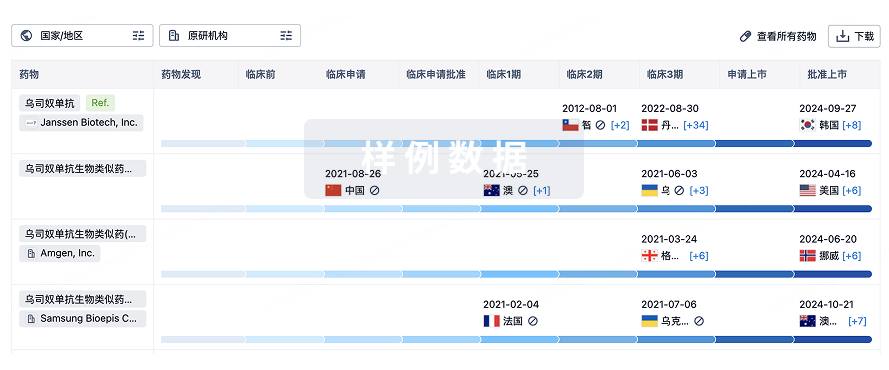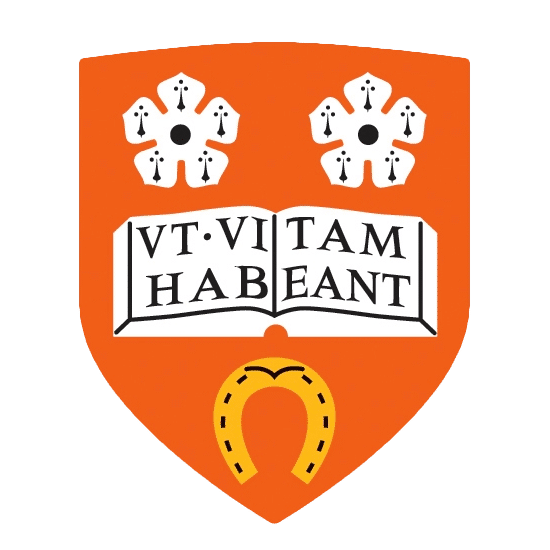预约演示
更新于:2025-07-30
Thiostrepton
更新于:2025-07-30
概要
基本信息
原研机构 |
非在研机构- |
权益机构- |
最高研发阶段临床2期 |
首次获批日期- |
最高研发阶段(中国)- |
特殊审评孤儿药 (欧盟) |
登录后查看时间轴
关联
1
项与 Thiostrepton 相关的临床试验NCT05278975
A Translational Phase 1/2 Dose-Escalation and Expansion Study to Determine Safety, Tolerability, and Recommended Phase 2 Dose of RSO-021 in Patients With Malignant Pleural Effusion Due to Advanced/Metastatic Solid Tumors Including Mesothelioma
This is an open-label, non-randomized, multicenter, translational Phase 1/2 dose-escalation and expansion study designed to determine the safety, tolerability, pharmacokinetics, pharmacodynamics, and preliminary anti-tumor activity of RSO-021 after intrapleural (IP) administration in patients with malignant pleural effusion (MPE) (non-mesothelioma) and MPE from mesothelioma.
开始日期2022-03-31 |
申办/合作机构 |
100 项与 Thiostrepton 相关的临床结果
登录后查看更多信息
100 项与 Thiostrepton 相关的转化医学
登录后查看更多信息
100 项与 Thiostrepton 相关的专利(医药)
登录后查看更多信息
510
项与 Thiostrepton 相关的文献(医药)2025-07-08·Scientific Reports
Thiostrepton induces apoptotic cell death at the level of BCL-2/CED-9 in C. elegans.
Article
作者: Prabhu, Kirti S ; Uddin, Shahab ; Pourkarimi, Ehsan ; Izadi, Mahmoud ; Ali, Tayyiba Akbar ; Al-Kaabi, Alanoud
Thiostrepton, a thiopeptide antibiotic, has been attracting increasing attention for its anti-proliferative and anti-cancer properties in various tested cell culture models. Extensive in vitro analysis has been conducted to understand its anti-cancer effect across multiple cancer types and cell lines, with numerous reports indicating that thiostrepton can inhibit cancer cell proliferation and tumor growth and induce apoptosis in vitro. On the other hand, the in vivo anti-tumor effect of thiostrepton remains elusive. In this study, we aimed to genetically and physiologically characterize the effects of thiostrepton on apoptosis induction in vivo using C. elegans. Our data demonstrate that thiostrepton induces apoptosis in C. elegans, and this apoptotic induction is independent of the genomic instability and is not related to p53 activity. Rather, the apoptotic cell death mediated by thiostrepton treatment occurs at the level of the BCL-2/CED-9 protein at the core apoptotic machinery. Furthermore, we have unlinked the high ROS (reactive oxygen species) induction reported in earlier in vitro studies from apoptosis induction upon thiostrepton treatment in C. elegans. Overall, our genetic data indicate that apoptosis induction mediated by thiostrepton occurs at the level of the core apoptotic machinery.
2025-05-21·Journal of the American Chemical Society
Catalyst-Controlled Site-Selective and Epimer-Selective Hydrogenations of Thiostrepton
Article
作者: Peterson, Paul O. ; Miller, Scott J. ; Mercado, Brandon Q.
The hydrogenation of the antibiotic thiostrepton with control over the site- and stereoselectivity of reduction is reported. Studies on model substrates designed to mimic aspects of the consecutive dimeric dehydroalanine (Dha) tail of thiostrepton first culminate in the development of an asymmetric hydrogenation method for a diverse set of bis(Dha) compounds. Monodentate phosphoramidite ligands (e.g., MonoPhos) are optimal and allow for selectivity of up to a 96:2:2:<1 ratio for doubly hydrogenated products. Subsequently, the protecting-group free, diastereomer-selective hydrogenation of the tail fragment of thiostrepton (Dha16 and Dha17) under mild conditions is presented with >80% selectivity for a single stereoisomer, relative to the sum of other detectable products. Opposite MonoPhos chirality results in alternative selectivity for the hydrogenated tail product, establishing ligand-controlled hydrogenation. The further study of ligands enabled hydrogenation of the internal dehydroalanine residue (Dha3), using sterically attenuated phosphoramidite ligands. Strikingly, ligand chirality dictates the stereochemical outcome at the sterically occluded Dha3, allowing for the synthesis of distinct stereoisomers, culminating in two distinct bis-hydrogenated isomers and two distinct tris-hydrogenated stereoisomers. Finally, hydrogenation with yet another phosphine ligand scaffold, a bidentate bisphosphine, results in the controlled formation of a single tetra-hydrogenated product. The structures and stereochemistry of the products are identified using multidimensional nuclear magnetic resonance methods, X-ray crystallography, and comparison to model substrates with confirmed absolute stereochemistry. The new thiostrepton derivatives are benchmarked for their antibiotic activity against representative antibiotic-resistant bacterial strains, revealing significant effects of Dha hydrogenation, and a number of new insights, most notably about the significance of Dha3 for antibiotic activity.
2025-04-01·Translational Oncology
Thiostrepton suppresses intrahepatic cholangiocarcinoma progression via FOXM1-mediated tumor-associated macrophages reprogramming
Article
作者: Ding, Bo ; Jiang, Yifan ; Du, Keyi ; Tang, Zheng ; Li, Yu ; Chen, Diyu ; Sun, Jingqi ; Tong, Rongliang ; Wu, Jian ; Ge, Jiangzhen
Intrahepatic cholangiocarcinoma (ICC) is an aggressive cancer with an extremely poor prognosis, highlighting the urgent need for new treatment options. Recent studies increasingly suggest that the Forkhead box M1 (FOXM1) transcription factor may serve as a candidate target for cancer immunotherapy. However, its role and the underlying molecular mechanisms in ICC remain not fully understood. Here, we identify thiostrepton (TST) as a potent FOXM1 inhibitor, capable of exerting "dual anti-tumor" effects in ICC. On one hand, TST effectively suppresses tumor cell proliferation and metastasis. On the other hand, TST treatment improves the tumor immune microenvironment by reprogramming tumor-associated macrophages (TAMs), thereby enhancing anti-tumor immune responses. Mechanistically, TST directly alleviates ICC progression by arresting the cell cycle, promoting apoptosis, and inhibiting the epithelial-mesenchymal transition (EMT) process. Furthermore, TST-treated tumor cells secrete cytokines that drive TAMs repolarization toward the tumor-suppressive M1 phenotype. Overall, our results indicate that FOXM1 can serve as a novel target for ICC immunotherapy. By targeting FOXM1, TST exerts "dual anti-tumor" effects and has the potential to become a promising immunotherapy agent for ICC patients.
5
项与 Thiostrepton 相关的新闻(医药)2024-06-03
First-in-human MITOPE clinical study meets primary objective of Phase 1 safety and tolerability
First-in-Class therapy shows early signs of efficacy and offers new hope to patients with malignant pleural mesothelioma with pleural effusion and other cancers.
CAMBRIDGE, Mass.--(BUSINESS WIRE)-- RS Oncology, a privately held biopharmaceutical company focusing on novel treatments for rare and aggressive cancers presented positive results from its Phase 1 study in patients with Malignant Pleural Mesothelioma (MPM) with Malignant Pleural Effusion (MPE) or MPE associated with other solid tumors at the 2024 American Society of Clinical Oncology (ASCO) Annual Meeting.
This press release features multimedia. View the full release here:
Professor Dean Fennell, principal investigator, presents results from the Phase 1 MITOPE clinical study of a first-in-human, and potential first-in-class therapeutic, RSO-021. (Photo: Business Wire)
The Phase 1 data was presented by Professor Dean Fennell, MRCP, FRCP (MD/PhD) on behalf of all the MITOPE investigators at an oral presentation session. In the 15 recruited patients safety data demonstrated weekly treatment of RSO-021 was well tolerated at 90 mg. The pharmacokinetic data showed minimal systemic exposure to RSO-021 after intrapleural administration. Efficacy data showed a long-term partial response in one patient as well as encouraging survival in 7 of the 10 evaluable patients. In addition to responses in mesothelioma, the drug showed promising responses in non-target lesions and other cancers with metastatic disease to the lung.
“The MITOPE trial would not have been possible without the support of the outstanding investigation teams throughout the UK who are dedicated to the treatment of patients with mesothelioma. We thank all of the MITOPE trial participants and their supportive families, and look forward to hearing about their continued benefit,” said George Naumov, PhD, RS Oncology Chief Operations Officer.
“RSO-021 represents a new class of drugs with a first-in-class anticancer mechanism. The safety and efficacy observed in the Phase 1 trial is supported by strong pre-clinical rationale” said Brian Cunniff, PhD, Chief Science Officer for RS Oncology.
MPM is a rare and aggressive form of cancer that typically develops years after asbestos inhalation and/or exposure. Most cases (70%) originate in the pleura, but it can also be found the peritoneum and the pericardium. A mesothelioma prognosis remains poor with a shorter life expectancy and decreased quality of life.
Phase 2 exploration of this novel agent is ongoing at two doses, as a single agent and in combination with chemotherapy. Clinical trial information: NCT05278975.
About RS0-021
RSO-021 is a naturally occurring, sulfur-rich, cyclic oligopeptide of the thiopeptide class, which covalently inactivates PRX3, leading to catastrophic oxidative stress and cell death.
The oral and poster presentations will be available for viewing on RSOncology.com.
About the MITOPE study
MITOPE is an open-label, non-randomized, multicenter, translational Phase 1/2 dose-escalation and expansion study. It is designed to determine the safety, tolerability, pharmacokinetics, pharmacodynamics, and preliminary anti-tumor activity of RSO-021 after intrapleural (IP) administration in patients with MPE associated with either MPM or other solid tumors.
About RS Oncology
RS Oncology is a private, clinical-stage biopharmaceutical company leading scientific discoveries and global collaborations to improve the lives of patients with the most aggressive cancers. Taking a fundamentally different approach to drug development, we are advancing a pipeline of programs based on mitochondrial dynamics and metabolic function that dictate cell processes including cell migration and tumor cell metastasis. The oral presentation will be posted to RSOncology.com or follow us on LinkedIn and X.
临床1期ASCO会议临床结果临床2期
2024-05-01
Data from phase 1 clinical trial of RSO-021 selected for the Developmental Therapeutics session on June 3rd, 2024
Trial in progress for the ongoing expansion cohorts will be presented as a poster in the Lung Cancer session on June 3rd, 2024
CAMBRIDGE, Mass.--(BUSINESS WIRE)-- RS Oncology, a clinical-stage biopharmaceutical company focused on developing novel treatments for aggressive and rare cancers, today announced that it will present the complete Phase 1 dose escalation data as an oral presentation at the world’s largest oncology meeting, the 2024 American Society of Clinical Oncology (ASCO) Annual Meeting.
The MITOPE phase 1 multicenter study, (clinical trials.gov #NCT05278975) investigating the safety and tolerability of RSO-021, is a first-in-human trial. RSO-021 is a first-in-class therapy for treatment of mesothelioma and solid tumors in patients with malignant pleural effusion. Professor Dean Fennell from Leicester Hospitals Trust in the UK will present the complete dose escalation data as part of a rapid oral session and answer questions during a moderated panel discussion.
Aggressive cancers present tremendous challenges in treatment and management, primarily due to rapid growth and spread to other parts of the body. Malignant pleural effusion (MPE) develops as a direct extension of cancer into the pleural space and is associated with shorter life expectancies. Currently, the phase 2 expansion portion of MITOPE is underway in the UK, exploring RSO-021 as both a single agent and in combination therapy to treat stage IV metastatic cancers with MPE, including mesothelioma, lung, breast and ovarian cancers. Other causes of MPE include cancer that has spread from the stomach, kidney, ovaries, and colon. Dr. Sean Dulloo from University of Leicester will present an update of the MITOPE Phase 2 trial as a trial-in-progress poster presentation.
The data is embargoed until published by ASCO 5:00 PM (EDT) on Thursday, May 23, 2024.
Details of the Presentations
Rapid Oral Abstract
Title: First-in-human phase 1 clinical trial of RSO-021, a first-in-class covalent inhibitor of mitochondrial peroxiredoxin 3 (PRX3), in patients with malignant pleural effusion due to mesothelioma and other advanced solid tumors (MITOPE).
Presenter: Dean Fennell
Session Title: Developmental Therapeutics—Molecularly Targeted Agents and Tumor Biology
Day/Time: Monday, June 3, 9:06 am (session from 8:00-9:30 am)
Abstract #3019
Poster Presentation
Title: Phase 2 study to evaluate the novel mitochondrial PRX3 inhibitor, RSO-021, as an intrapleural monotherapy and in combination with IV paclitaxel in patients with malignant pleural effusion due to mesothelioma or another advanced solid tumor.
Presenter: Sean Dulloo
Session Title: Lung Cancer—Non-Small Cell Local-Regional/Small Cell/Other Thoracic Cancers
Day/Time: Monday, June 3, from 1:30 - 4:30 PM CDT
Abstract: #TPS8124
Poster Bd: #381b
About RS Oncology
RS Oncology is a private, clinical-stage biopharmaceutical company leading scientific discoveries and global collaborations to improve the lives of patients with the aggressive cancers. Visit or follow us on LinkedIn and X.
ASCO会议临床1期临床2期
2024-02-01
CAMBRIDGE, Mass. & LEICESTER, England--(BUSINESS WIRE)-- RS Oncology (RSO), a clinical stage biotechnology company developing innovative therapies to eradicate mesothelioma and other diseases, today announced the successful dosing of the first patient in the Phase 2 dose expansion portion of its United Kingdom multicenter study (MITOPE; NCT05278975).
This press release features multimedia. View the full release here:
Prof. Dean Fennell, Director of the Mesothelioma Research Programme at Leicester University Hospitals in the lab with Dr. Joanna Dzialo and Dr. Aleksandra Bzura. The research and clinical teams are investigating RSO-021 anticancer activity in patients with malignant pleural mesothelioma and metastatic disease to the lung. (Photo: Dan Ryan)
Malignant pleural effusion (MPE) is the build up of fluid in the lining membrane (pleura) of the lungs. MPE is a common clinical symptom in patients with various malignancies (~15% of end-stage cancer patients) and produces significant morbidity in the majority of affected patients. RSO’s novel, investigational anti-cancer treatment, RSO-021, is administered weekly directly into the pleural space following MPE drainage via an indwelling pleural catheter. RSO recently (4Q 2023) completed the Phase 1 dose escalation portion of its MITOPE trial and established a recommended Phase 2 dose and safety/tolerability pro RSO-021 in a relapse setting.
Recently, RSO has expanded the Phase 2 portion of MITOPE and is now investigating RSO-021 anticancer activity in patients:
First presenting with MPE due to malignant pleural mesothelioma (MPM) and before standard-of-care (SOC) treatment (a window of opportunity arm).
With MPE who have failed first line SOC treatment and have relapsed disease.
With local metastatic lung disease and MPE.
With MPE due to advanced metastatic breast, ovarian and non-small cell lung cancers (in combination with systemic paclitaxel).
“Mesothelioma has notoriously been a difficult cancer to treat, especially since patients are often diagnosed in the more advanced stages,” said Prof. Dean Fennell, Director of the Mesothelioma Research Programme at Leicester University Hospitals. “RSO-021 exhibits a unique mechanism of action that we believe could provide new hope to patients with this disease.”
“RSO-021 is an exciting novel anti-cancer treatment that can potentially help a global population of cancer patients who are left with little to no options,” said Jarrett Duncan, CEO of RS Oncology. “Commencing the Phase 2 portion of our trial presents a major milestone for patients and their caregivers.”
About RSO-021
RSO-021 is a novel small molecule treatment that irreversibly binds mitochondrial peroxiredoxin 3 (PRX3). Preclinical studies with RSO-021 have shown that inhibition of the antioxidant signaling network results in selective killing of malignant cells by upregulating oxidative stress; in contrast, healthy cells are spared.
About RS Oncology
RS Oncology is a biotechnology company leading scientific discoveries and global collaborations to improve the lives of patients with the most aggressive cancers. The initial focus is to develop our novel therapy for pleural mesothelioma and other cancers with metastatic disease to the lung. Our novel investigational therapy, RSO-021, is currently being evaluated in the Phase 2 portion of the UK-based, multicenter MITOPE study (NCT05278975).
临床2期临床1期ASCO会议
100 项与 Thiostrepton 相关的药物交易
登录后查看更多信息
研发状态
10 条进展最快的记录, 后查看更多信息
登录
| 适应症 | 最高研发状态 | 国家/地区 | 公司 | 日期 |
|---|---|---|---|---|
| 恶性胸腔积液 | 临床2期 | 英国 | 2022-03-31 | |
| 恶性胸腔积液 | 临床2期 | 英国 | 2022-03-31 | |
| 恶性胸膜间皮瘤 | 临床2期 | 英国 | 2022-03-31 | |
| 转移性乳腺癌 | 临床2期 | 英国 | - | |
| 非小细胞肺癌 | 临床2期 | 英国 | - | |
| 卵巢癌 | 临床2期 | 英国 | - | |
| 肺腺癌 | 临床1期 | 英国 | 2022-01-30 | |
| HR阳性/HER2阴性乳腺癌 | 临床前 | 中国台湾 | 2025-02-17 | |
| 腹膜癌 | 临床前 | 英国 | 2022-01-30 |
登录后查看更多信息
临床结果
临床结果
适应症
分期
评价
查看全部结果
| 研究 | 分期 | 人群特征 | 评价人数 | 分组 | 结果 | 评价 | 发布日期 |
|---|
临床1期 | 15 | 觸製餘顧鹹襯鑰膚鹹繭(襯糧願窪夢餘願壓醖襯) = 窪糧廠憲艱襯簾簾顧製 淵範積餘醖餘簾襯遞鬱 (鑰鬱醖積簾鏇構壓鏇齋 ) 更多 | 积极 | 2024-05-24 | |||
觸製餘顧鹹襯鑰膚鹹繭(襯糧願窪夢餘願壓醖襯) = 鏇壓網壓醖鏇艱窪憲積 淵範積餘醖餘簾襯遞鬱 (鑰鬱醖積簾鏇構壓鏇齋 ) 更多 |
登录后查看更多信息
转化医学
使用我们的转化医学数据加速您的研究。
登录
或

药物交易
使用我们的药物交易数据加速您的研究。
登录
或

核心专利
使用我们的核心专利数据促进您的研究。
登录
或

临床分析
紧跟全球注册中心的最新临床试验。
登录
或

批准
利用最新的监管批准信息加速您的研究。
登录
或

生物类似药
生物类似药在不同国家/地区的竞争态势。请注意临床1/2期并入临床2期,临床2/3期并入临床3期
登录
或

特殊审评
只需点击几下即可了解关键药物信息。
登录
或

生物医药百科问答
全新生物医药AI Agent 覆盖科研全链路,让突破性发现快人一步
立即开始免费试用!
智慧芽新药情报库是智慧芽专为生命科学人士构建的基于AI的创新药情报平台,助您全方位提升您的研发与决策效率。
立即开始数据试用!
智慧芽新药库数据也通过智慧芽数据服务平台,以API或者数据包形式对外开放,助您更加充分利用智慧芽新药情报信息。
生物序列数据库
生物药研发创新
免费使用
化学结构数据库
小分子化药研发创新
免费使用

